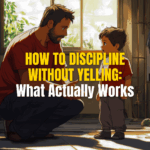You love your kids. You want the best for them. But in the heat of the moment—when they’re testing your patience or ignoring your words—it’s easy to slip into yelling. We’ve all been there. Still, the question lingers:
Can I discipline without yelling and still be respected as a father?
The answer is yes and the secret lies in a surprising source: Stoic philosophy.
As modern dads, we don’t need to be authoritarian or passive. We need to be calm, consistent, and clear. In this post, you’ll learn how Stoicism offers powerful tools for disciplining your child without yelling and why that shift matters more than you might think.
I want to point out that I grew up with a lot of yelling, and threats in my household. It was constantly a game of walking on eggshells and you never knew where the next freak out would come from. Because of this, I started coming at this from the other side of things, where I would let my kids get away with more. And I have been guilty of yelling. What dad hasn’t? But it’s what you do after this happens to keep the relationship strong.
Why Yelling Doesn’t Work, And What It Teaches Your Kids
Let’s get this out of the way: yelling doesn’t make you a bad parent. But it’s often a sign that your emotional regulation is overwhelmed and kids pick up on that.
In fact, research shows that yelling can have long-term negative effects on children:
- A 2014 study published in Child Development found that harsh verbal discipline (including yelling) was linked to increased behavior problems and symptoms of depression in adolescents.
(Wang, Y., et al., 2014) - Additional research highlights that yelling increases fear, not understanding, often leading to more defiance or emotional withdrawal.
(Sheehan & Watson, 2019)
When we yell, we’re not modeling strength—we’re modeling emotional instability. It’s a reactionary response to your childs actions. Sometimes its out of desparation that we end up trying to yell to stop their actions.
But yelling teaches kids:
- That big emotions justify big reactions.
- That loudness equals control.
- That conflict is something to win, not understand.

The Stoic Foundation of Calm Parenting
Enter Stoicism.
This ancient philosophy isn’t about suppressing emotion, it’s about mastering it. As Epictetus said:
“No man is free who is not master of himself.”
Stoic parenting means recognizing that you can’t control your child’s behavior, but you can always control your response.
“Waste no more time arguing what a good man should be. Be one.” – Marcus Aurelius
Core Stoic principles that apply directly to discipline:
- The dichotomy of control: You control your actions, not their reactions.
- Emotional regulation: Your ability to stay calm teaches your child emotional resilience.
- Role modeling: You live the virtues you want them to adopt—calm, courage, patience.
When your child is melting down, your job isn’t to escalate, it’s to be the calmest one in the room.
Calm Parenting Strategies That Actually Work
Here are Stoic-aligned, evidence-based strategies to discipline without yelling:
Lower Your Tone, Raise Your Intention
Yelling raises emotional intensity. Speaking low and slow does the opposite, it signals control. A calm tone disarms resistance and commands more respect than volume.
Tip: Practice speaking just above a whisper when emotions are high. It invites attention, not opposition.
This can still be tough sometimes especially when you are right in the middle of a 4 year old melting down, but keeping this calm, and not letting their reactions effect you, will allow them to start calming down.
Create Pre-Set Boundaries, Not Reactive Punishments
Stoics didn’t wait for emotion to decide action, they followed principles. Set clear expectations ahead of time, so you’re never reacting, only enforcing what was already agreed upon.
Example: “If toys aren’t cleaned up by bedtime, they go away for a day.” Calm. Clear. Consistent.
My 6 year old Henry is on the low end spectrum for Autism. One of the things we really focus on is setting realistic expectations as sometimes he can completely melt down when he doesn’t get what he wants. Giving him a heads up ahead of time sets him up for success. Quite often there is less of a melt down, because we reset the boundary and expectation.
Use Silence and Presence as Tools
When your child acts out, you don’t always need to lecture. Sometimes, a quiet pause, a steady presence, and a few deep breaths speak louder than words.
Presence teaches regulation. Reactivity teaches chaos. That definitely does NOT mean you use silence as a means of punishment. But a small childs brain is still learning to process emotions so a giant melt down, might just need a couple minutes of giving them space to feel their emotions. The dad will take some deep breaths and prepare because as the child calms down all they will want is a big hug from their dad. Be present through all of this.
Narrate the Moment, Not the Emotion
Help your child name what’s happening without judgment. Instead of “Stop crying!” say, “You’re feeling frustrated because it didn’t go your way. That’s hard.” Instead of trying to blame, just ask questions in a mindful way.
This builds emotional intelligence, not fear-based obedience.
Positive Discipline Techniques for Dads
You don’t need punishment to teach a lesson. You need consequences with purpose and connection over control.
Here’s what positive discipline looks like:
Natural Consequences
Let reality be the teacher.
If they refuse to wear a coat, let them feel the chill (within safe limits). Experience is more memorable than a lecture. Risky play is a big thing in our household and it allows Henry and Sal to explore and grow, but still realize there is a risk.
Redirection
Especially with toddlers, shift their attention to something constructive. It’s not about distraction, it’s about guidance.
Reconnection After Correction
After any disciplinary moment, come back. Let them know they’re still loved. This solidifies security, not shame.
Research from the American Academy of Pediatrics affirms that positive discipline encourages empathy, problem-solving, and internal motivation—things punishment can’t reach.
Age-Appropriate Discipline Ideas
Different ages call for different tools. Here’s a Stoic-inspired guide.
Toddlers (1–3)
- Use redirection and repetition. Keep it simple.
- Offer two choices: “Do you want to put your toy away or have me help you?”
Preschool and Early School Age (4–7)
- Use logical consequences and preview outcomes: “If you hit, the game ends.”
- Model pause-and-breathe techniques, yes, even at this age. Sal is getting better at, after she has calmed down a bit during a meltdown, her and I
Older Kids (8–12)
- Involve them in setting rules and consequences.
- Introduce reflection: “What do you think could’ve gone differently?”
This shift from power-over to power-with encourages real growth and maturity.
A Final Word to Stoic Fathers
Discipline isn’t about control. It’s about guidance, integrity, and calm strength.
When you yell, you might get obedience—but at the cost of connection. When you lead calmly, you build trust, respect, and self-awareness in your child.
You don’t need to be perfect. But you do need to be intentional.
Your discipline doesn’t start with your child. It starts with you.





